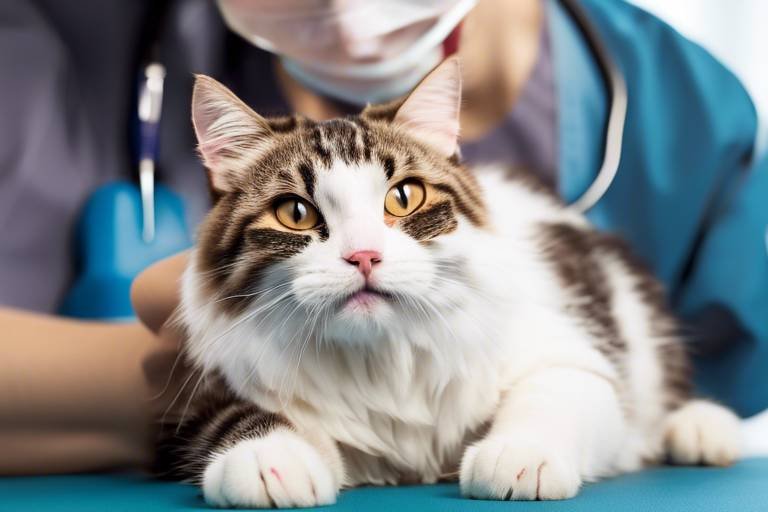The Benefits of Spaying and Neutering for Behavior
When it comes to our beloved pets, we want the best for them, right? One of the most impactful decisions you can make as a pet owner is to spay or neuter your furry friend. Not only does this procedure help in controlling the pet population, but it also plays a significant role in improving their behavior. Imagine a world where your dog is less aggressive, your cat isn’t marking its territory, and both are less likely to roam the streets. Sounds like a dream, doesn’t it? Well, spaying and neutering can help turn that dream into reality!
In this article, we’ll dive deep into the myriad of benefits that come from these procedures, focusing specifically on how they can positively influence your pet's behavior. We'll explore everything from reducing aggression to minimizing roaming tendencies, all while ensuring that your pet lives a healthier, happier life. So, let’s get started on this enlightening journey!
Before we jump into the behavioral benefits, it's crucial to understand what spaying and neutering actually entail. Spaying refers to the surgical procedure performed on female animals, where the ovaries and usually the uterus are removed. On the other hand, neutering is the term used for males, which involves the removal of the testicles. Both procedures are typically done under anesthesia and are considered routine surgeries in veterinary medicine.
Now, you might be wondering about the differences between the two. While both procedures aim to prevent reproduction, they also significantly impact behavior. For instance, spayed females often experience fewer mood swings, while neutered males tend to exhibit less territorial aggression. Understanding these differences can help you make informed decisions about your pet's health and behavior.
So, what can you expect in terms of behavior after your pet has undergone spaying or neutering? The changes can be quite remarkable! Many pet owners report noticeable improvements in their pets' behavior shortly after the surgery. This includes a reduction in aggression, a decrease in roaming, and even less marking behavior. Let’s break these down further.
Aggression in pets can lead to a host of problems, both for the animal and its owner. Fortunately, spaying and neutering can significantly reduce aggressive behaviors. This is particularly true for male pets, who often exhibit territorial aggression and dominance-related issues. When neutered, these behaviors tend to diminish, leading to a more peaceful household.
Neutering male pets is known to lower their aggression levels. Without the influence of testosterone, many males become less likely to engage in fights or display dominance over other pets. This means fewer trips to the vet for injuries and a more harmonious environment for everyone involved.
On the flip side, spaying female pets can help reduce mood swings and aggression linked to their hormonal cycles. Female dogs, for example, can become irritable or aggressive when in heat. By spaying them, you not only prevent unwanted litters but also create a calmer and more stable pet.
Another significant behavioral change you can expect post-surgery is a decrease in roaming. Pets have a natural instinct to seek out mates, which often leads them to wander far from home. This wandering can result in dangerous situations, such as getting lost or injured. Spaying and neutering help curb this instinct, ensuring your pet stays safe and sound at home.
While we’ve focused on behavior so far, it’s essential to note that spaying and neutering also come with health benefits that indirectly contribute to better behavior. For instance, these procedures can prevent certain diseases that might otherwise lead to behavioral changes due to pain or discomfort.
Spaying and neutering can prevent reproductive health issues, such as uterine infections and testicular cancer. By keeping your pet healthy, you reduce the likelihood of them exhibiting behavioral changes due to illness, ensuring they remain stable and happy companions.
Did you know that spayed and neutered pets often enjoy longer, healthier lives? This longevity can positively influence their behavior and interactions with family members. A healthy pet is a happy pet, and a happy pet is much more likely to exhibit desirable behaviors.
The benefits of spaying and neutering extend beyond individual households. When communities embrace these practices, the impact can be profound. Spaying and neutering help control pet overpopulation, which can lead to fewer animals in shelters and a lower incidence of abandonment. This, in turn, improves the overall welfare of animals in the community.
Overpopulation is a significant issue that many communities face. By spaying and neutering pets, we can help control this problem, leading to fewer strays on the streets and less strain on local shelters. It’s a win-win for everyone!
Community efforts in spaying and neutering not only reduce the number of unwanted animals but also enhance the quality of life for those that remain. Responsible pet ownership becomes the norm, and animals can thrive in loving homes rather than suffering on the streets.
Q: At what age should I spay or neuter my pet?
A: Most veterinarians recommend spaying or neutering pets around six months of age, but it's best to consult your vet for personalized advice.
Q: Will my pet gain weight after being spayed or neutered?
A: Weight gain can occur if pets are overfed or not exercised adequately. Monitoring their diet and activity level is key.
Q: Is the surgery safe?
A: Yes, spaying and neutering are considered safe procedures when performed by a qualified veterinarian.
Q: Can spaying or neutering change my pet's personality?
A: While some behaviors may change, most pets retain their unique personalities. The goal is to reduce undesirable behaviors, not change who they are.

Understanding Spaying and Neutering
When it comes to being a responsible pet owner, understanding the concepts of spaying and neutering is essential. These terms refer to surgical procedures that help control the pet population and improve the behavior and health of our furry friends. But what exactly do these procedures entail? Let's break it down.
Spaying is the surgical procedure performed on female animals to remove their ovaries and usually the uterus. This procedure not only prevents unwanted pregnancies but also eliminates the heat cycles that can cause behavioral changes in female pets. On the other hand, neutering refers to the removal of the testicles in male animals. This procedure helps control male behaviors such as marking territory and aggression, making them more docile companions.
Both procedures are typically performed by a veterinarian under general anesthesia, ensuring that the pet feels no pain during the operation. Recovery usually takes a few days, during which pet owners must monitor their pets to ensure they heal properly. It's crucial to follow your vet's post-operative care instructions to ensure a smooth recovery.
Now, you might be wondering, "What are the actual differences between spaying and neutering?" While both aim to prevent reproduction, the main difference lies in the gender of the pet and the specific organs that are removed. To summarize:
| Procedure | Gender | What is Removed? |
|---|---|---|
| Spaying | Female | Ovaries and usually the uterus |
| Neutering | Male | Testicles |
Understanding these procedures is the first step in becoming a responsible pet owner. Not only do spaying and neutering help control the pet population, but they also contribute to the overall well-being of pets and their owners. A pet that is spayed or neutered is generally healthier and exhibits better behavior, which leads to a more harmonious environment at home. So, if you're considering these options for your pet, know that you're making a positive choice for your furry family member!

Behavioral Changes Post-Surgery
When it comes to our furry friends, the decision to spay or neuter can feel monumental. However, the **benefits** of these procedures extend far beyond just population control; they can significantly enhance your pet's behavior. After surgery, many pet owners report noticeable changes in their pets, and these changes can lead to a more harmonious home environment. Imagine your once rambunctious dog settling down into a calm companion or your feisty feline becoming a cuddly lap cat—sounds appealing, right?
One of the most common behavioral improvements observed post-surgery is a reduction in aggression. This is particularly true for male pets, where neutering often leads to a marked decrease in aggressive tendencies. Without the drive to assert dominance or compete for females, many male pets become more relaxed and manageable. For instance, a dog that used to bark and growl at every passerby may transform into a more sociable creature, eager to greet visitors instead of scaring them off.
But what about our female friends? Spaying can also have a profound impact on their behavior. Many female pets experience mood swings linked to their hormonal cycles, which can lead to irritability and aggression. By spaying, you help regulate these hormonal fluctuations, resulting in a calmer and more stable temperament. Picture a once moody cat now purring contentedly on your lap—it's a win-win situation!
Neutering male pets not only curbs aggression but also reduces territorial behaviors. This means fewer conflicts with other pets and a decrease in the tendency to mark territory. In households with multiple pets, this can lead to a much more peaceful coexistence. For example, a neutered male dog may no longer feel the need to assert his dominance over others, allowing for a more balanced pack dynamic.
On the flip side, spaying female pets can lead to a noticeable decrease in behaviors associated with their heat cycles. Female dogs and cats often exhibit restless, anxious behaviors when in heat, making them difficult to manage. After spaying, these behaviors typically diminish, allowing for a more relaxed pet that fits seamlessly into family life. This can be especially beneficial for families with children, as a calmer pet is generally more tolerant and gentle.
Another significant behavior change following spaying or neutering is the reduction in roaming tendencies. Pets that are not spayed or neutered often feel a strong urge to roam in search of mates, which can lead to dangerous situations, such as traffic accidents or getting lost. By spaying or neutering, you effectively curb this instinct, keeping your pet safe at home. It's like putting a fence around their heart—ensuring they stay close to the ones they love.
Overall, the behavioral changes post-surgery can create a more peaceful home environment, benefiting both pets and their owners. A well-behaved pet is not only a joy to have around but can also lead to a stronger bond between you and your furry companion. So, if you're on the fence about spaying or neutering, remember the potential for a calmer, happier pet that enhances your family's life.
- Will my pet's personality change after spaying or neutering? Most pets retain their unique personalities, but they may exhibit more stable and calm behaviors.
- What is the best age to spay or neuter my pet? Generally, it's recommended to spay or neuter pets between six months to one year of age, but consult your veterinarian for specific advice.
- Are there any risks associated with spaying or neutering? As with any surgery, there are risks, but they are generally low. Your vet will discuss these with you before the procedure.
- How long does it take for my pet to recover from surgery? Most pets recover within a few days, but full recovery can take about two weeks.
Reduction in Aggression
When it comes to our furry friends, one of the most significant benefits of spaying and neutering is the reduction in aggressive behaviors. Many pet owners have experienced the challenges that come with an aggressive pet—whether it’s barking at strangers, growling at other animals, or even showing signs of territoriality. These behaviors can lead to stress not just for the pet but also for the entire household. But fear not! Spaying and neutering can play a crucial role in turning down the volume on aggression.
So, how does this work? Well, the root of many aggressive behaviors in pets, especially males, is linked to their hormones. Male dogs, for instance, are often driven by testosterone, which can lead to heightened aggression and dominance displays. By neutering, you’re essentially reducing the levels of this hormone, which can lead to a more calm and manageable companion. Imagine a once rowdy teenager mellowing out after a good talk with their parents—that’s what neutering does for many male dogs!
On the flip side, female pets also experience behavioral changes post-spaying. During their heat cycles, females can exhibit mood swings and increased irritability, which can be misinterpreted as aggression. By spaying, you eliminate these hormonal fluctuations, leading to a more stable and friendly demeanor. It’s like taking a deep breath after a stressful day; suddenly, everything feels a bit more relaxed.
Here are a few key points to consider regarding the reduction of aggression through spaying and neutering:
- Males: Neutering significantly lowers aggression levels and territorial behaviors, making them easier to manage.
- Females: Spaying reduces mood swings and aggression associated with hormonal cycles, leading to a calmer personality.
- Overall Impact: A less aggressive pet contributes to a more peaceful household, reducing stress for both pets and owners.
In summary, spaying and neutering aren’t just surgical procedures; they are transformative experiences that can lead to happier, healthier, and more harmonious homes. If you're still on the fence about whether to spay or neuter your pet, consider the long-term benefits of a less aggressive companion. Your future self—and your pet—will thank you!
1. Will spaying or neutering change my pet's personality?
While spaying and neutering can reduce aggressive behaviors, it typically doesn't change your pet's core personality. They may become calmer and less aggressive, but their unique traits will still shine through.
2. At what age should I spay or neuter my pet?
Most veterinarians recommend spaying or neutering pets between 6 months and 1 year of age, but it's best to consult with your vet for personalized advice based on your pet's health and breed.
3. Are there any risks associated with spaying or neutering?
Like any surgical procedure, there are risks involved, but they are generally low. The benefits of spaying and neutering often outweigh the risks, especially concerning behavioral improvements and health benefits.
4. Can spaying or neutering help with my pet's anxiety?
While it may not directly address anxiety, reducing aggression and hormonal fluctuations can lead to a more relaxed pet, which may help alleviate some anxiety-related behaviors.
Impact on Males
Neutering male pets can have a profound impact on their behavior, transforming them into more manageable and friendly companions. One of the most significant changes observed is a noticeable reduction in aggression. Without the influence of testosterone, male pets often exhibit less territorial behavior and are less likely to engage in fights with other animals. This can lead to a more peaceful household environment, where both pets and humans can coexist without the stress of potential altercations.
Additionally, neutered males tend to roam less. When intact, male pets may feel the urge to wander off in search of a mate, putting them at risk of accidents or getting lost. By neutering, you effectively curb this instinct, allowing your furry friend to enjoy the outdoors safely, without the constant desire to explore beyond your yard. This not only protects your pet but also alleviates concerns about their safety and well-being.
Another interesting aspect of neutering is its impact on marking behavior. Many male pets engage in urine marking to establish their territory. After neutering, this behavior often diminishes significantly. Owners frequently report that their pets stop marking inside the house, leading to a cleaner living space and a more harmonious relationship between pets and their owners.
In summary, neutering male pets can lead to a variety of positive behavioral changes, including:
- Decreased aggression: A calmer demeanor contributes to a more peaceful home.
- Less roaming: Reduces the risk of accidents and keeps pets safe.
- Fewer marking incidents: Leads to a cleaner and more pleasant living environment.
Ultimately, the decision to neuter a male pet can significantly enhance their behavior, making them more enjoyable companions and fostering a better relationship with their human families. It’s a choice that not only benefits the individual pet but also contributes to a more harmonious community of pet owners.
Q: What age is best for neutering my male pet?
A: Most veterinarians recommend neutering male pets between six months and one year of age, but it can vary based on the breed and health of your pet. Always consult with your vet for personalized advice.
Q: Will neutering change my pet's personality?
A: Neutering typically leads to a reduction in aggressive behaviors and roaming tendencies, but it shouldn't change your pet's core personality. They will still be the same loving companion you know!
Q: Are there any health risks associated with neutering?
A: Like any surgical procedure, neutering carries some risks, but they are generally minimal. The health benefits, such as reduced risk of certain diseases, often outweigh these risks. Always discuss concerns with your veterinarian.
Impact on Females
When it comes to spaying female pets, the benefits extend far beyond just preventing unwanted litters. One of the most significant impacts is the reduction of mood swings and aggression that many female pets experience during their hormonal cycles. Imagine a rollercoaster ride of emotions—one moment they're sweet and cuddly, and the next, they might be hissing or snapping at anyone who dares to come close. This unpredictability can be stressful for both the pet and the owner. By spaying, we can help stabilize their hormonal fluctuations, leading to a much calmer and more predictable demeanor.
Moreover, spaying can also reduce the likelihood of certain hormonal-related behaviors, such as nesting or excessive vocalization, which can be quite disruptive in a household. Without the drive to reproduce, many female pets find themselves more at ease, allowing them to enjoy their time with their families without the constant urge to seek out a mate. This not only enhances their overall happiness but also fosters a stronger bond between pets and their owners.
Additionally, spaying can prevent serious health issues that may arise from hormonal imbalances, such as pyometra (a severe uterine infection) and certain types of cancers. By eliminating the risk of these conditions, we not only ensure a healthier pet but also contribute to a more stable and pleasant living environment. A healthy pet is typically a happier pet, and that happiness translates into better behavior. Furthermore, with fewer health issues to worry about, pet owners can focus on the fun aspects of pet ownership, like playtime and training.
In summary, spaying female pets can lead to:
- Reduced Aggression: Less moodiness and irritability during hormonal cycles.
- Improved Stability: A calmer demeanor leads to better interactions with family members.
- Health Benefits: Lower risk of serious reproductive health issues.
By making the choice to spay, pet owners not only contribute to the well-being of their furry friends but also create a more harmonious home environment. It’s a win-win situation that enhances the quality of life for both pets and their families.
Q: At what age should I spay my female pet?
A: It's generally recommended to spay female pets between six months and one year of age, but consulting your veterinarian is key to determining the best time based on your pet's breed and health.
Q: Will spaying change my pet's personality?
A: While spaying can lead to a calmer demeanor, it won't change your pet's core personality. Instead, it may help reduce unwanted behaviors associated with hormonal cycles.
Q: Are there any risks associated with spaying?
A: Like any surgical procedure, spaying does carry some risks, but they are generally minimal. The benefits, such as preventing unwanted litters and reducing health risks, often outweigh these concerns.
Q: Can I spay my pet if she is already pregnant?
A: It is possible to spay a pregnant pet, but it's a more complex procedure. It's essential to discuss this with your veterinarian to understand the implications.
Decreased Roaming Behavior
One of the most significant behavioral changes observed in pets after spaying or neutering is the notable decrease in roaming behavior. Before these procedures, many pets, especially males, have an instinctual drive to wander in search of a mate. This natural urge can lead them into dangerous situations, such as traffic, fights with other animals, or getting lost. However, once they are spayed or neutered, this instinct diminishes significantly.
Imagine your pet as a ship sailing the vast ocean, always searching for the next port of call. After spaying or neutering, that ship is more likely to anchor in safe harbor rather than drift aimlessly. This change not only ensures their safety but also provides peace of mind for pet owners. You can finally relax without worrying about your furry friend escaping through the door the moment it opens!
Furthermore, the reduction in roaming behavior contributes to a more stable home environment. When pets feel less compelled to explore the outside world, they tend to be more content and focused on their surroundings. This leads to better bonding with their families and a more enjoyable home life. Less roaming means fewer opportunities for mischief, resulting in a calmer household overall.
It's essential to understand that spaying and neutering don't just affect individual pets; they have a broader impact on the community. When fewer pets roam the streets, the chances of accidents and conflicts decrease. This contributes to a safer neighborhood for everyone, including other pets and people. So, by choosing to spay or neuter your pet, you're not only improving their behavior but also playing a part in creating a more harmonious community.
In summary, spaying and neutering are vital steps in managing your pet's roaming behavior. By reducing their instinct to wander, you enhance their safety, improve their behavior, and foster a more peaceful environment for both your pet and your family. It’s a win-win situation that benefits everyone involved!
- Q: At what age should I spay or neuter my pet?
A: Most veterinarians recommend spaying or neutering pets between 6 to 12 months of age, but it's best to consult with your vet for personalized advice. - Q: Will my pet's personality change after spaying or neutering?
A: While some behaviors may improve, your pet's core personality will remain the same. They may become calmer and less aggressive, but their unique traits will shine through. - Q: Can spaying or neutering lead to weight gain?
A: Yes, some pets may gain weight post-surgery due to hormonal changes. It's essential to monitor their diet and exercise to maintain a healthy weight. - Q: Is spaying or neutering a painful procedure?
A: The procedures are performed under anesthesia, so your pet will not feel pain during the surgery. Post-operative care is important to ensure a smooth recovery.

Health Benefits Related to Behavior
When it comes to our beloved pets, their health is intricately linked to their behavior. Spaying and neutering not only contribute to controlling the pet population but also play a crucial role in enhancing the overall health of our furry friends. This, in turn, can lead to significant behavioral improvements. For instance, pets that are spayed or neutered tend to exhibit fewer behavioral issues stemming from hormonal fluctuations. This is especially true for female pets, who can experience mood swings and aggressive tendencies during their heat cycles. By eliminating these cycles, spaying helps create a more stable and calm environment.
Moreover, the health benefits of spaying and neutering extend beyond just behavior. These surgical procedures can prevent a range of reproductive health issues, which can lead to both physical and psychological stress in pets. For example, unspayed females are at risk of developing conditions like pyometra, a serious infection of the uterus, which can cause pain and discomfort. Similarly, unneutered males may face testicular cancer and prostate problems, which can result in irritability and aggression. By addressing these potential health risks, pet owners can help ensure their companions remain happy and well-adjusted.
Let's take a closer look at some of the key health benefits related to behavior:
| Health Benefit | Behavioral Impact |
|---|---|
| Prevention of Reproductive Diseases | Reduces stress and discomfort, leading to a calmer pet. |
| Lower Risk of Certain Cancers | Decreases aggression and anxiety associated with health issues. |
| Longer Lifespan | Allows for more time to bond with families, leading to improved behavior. |
In addition to these direct benefits, spayed and neutered pets often enjoy a longer lifespan. This is significant because a longer life means more time spent with their families, fostering stronger bonds and enhancing their overall behavior. Pets that feel secure and loved are less likely to exhibit anxiety-related behaviors, such as excessive barking or destructive tendencies.
Furthermore, the peace of mind that comes with knowing your pet is healthy can also reduce stress for pet owners. A relaxed owner typically leads to a relaxed pet. It’s a beautiful cycle: when you invest in your pet's health through spaying or neutering, you are not only enhancing their well-being but also creating a more harmonious household.
In summary, the health benefits related to behavior from spaying and neutering are profound. Not only do these procedures prevent serious health issues, but they also promote a stable and calm demeanor in pets. By prioritizing their health, we ultimately enrich their lives and our own.
- What is the best age to spay or neuter my pet?
Most veterinarians recommend spaying or neutering pets around six months of age, but it can vary based on the breed and health of your pet. - Will spaying or neutering change my pet's personality?
No, spaying or neutering will not change your pet's core personality, but it can help reduce undesirable behaviors linked to hormones. - Are there any risks associated with spaying or neutering?
Like any surgical procedure, there are risks, but they are generally low. Your veterinarian will provide you with all the necessary information to make an informed decision.
Prevention of Certain Diseases
One of the most compelling reasons to consider spaying and neutering your pets is the significant . These surgical procedures not only help in controlling the pet population but also play a pivotal role in enhancing the overall health of your furry friends. For instance, spaying female pets can drastically reduce the risk of developing serious health issues such as pyometra (a severe uterine infection) and certain types of cancer, including mammary tumors. Studies have shown that spaying before the first heat cycle can reduce the risk of mammary cancer by up to 90%! Now, that's a statistic worth considering!
On the other hand, neutering male pets can prevent testicular cancer and significantly lower the chances of developing prostate problems. Think of it this way: by taking this responsible step, you're not just protecting your pet from potential health issues; you're also saving yourself from the emotional turmoil and financial burden that comes with treating these conditions. It’s like giving your pet a health insurance policy that pays off in the long run!
Moreover, pets that are spayed or neutered tend to have fewer behavioral problems related to their reproductive hormones. For example, unspayed females often experience mood swings and behavioral changes during their heat cycles, which can be stressful for both the pet and the owner. By preventing these hormonal fluctuations, spaying helps in promoting a more stable and pleasant temperament in female pets.
To summarize the health benefits related to spaying and neutering, let’s take a look at the following table:
| Procedure | Health Benefits |
|---|---|
| Spaying |
|
| Neutering |
|
In conclusion, spaying and neutering are not just about controlling the pet population; they are crucial for ensuring a healthier and happier life for your pets. By taking these steps, you are investing in their health and well-being, which ultimately leads to a more harmonious relationship between you and your beloved companions.
Q: At what age should I spay or neuter my pet?
A: It's typically recommended to spay or neuter pets around six months of age, but consult your veterinarian for personalized advice.
Q: Will spaying or neutering change my pet's personality?
A: While it may reduce certain behaviors related to hormones, such as aggression or marking, it generally does not change your pet's fundamental personality.
Q: Are there any risks associated with spaying or neutering?
A: Like any surgical procedure, there are risks, but they are minimal. The benefits usually outweigh the risks, especially when done by a qualified veterinarian.
Q: How long does the recovery take after spaying or neutering?
A: Most pets recover within a few days, but it's essential to follow your veterinarian's post-operative care instructions for the best results.
Longer Lifespan and Quality of Life
When it comes to our furry companions, who wouldn’t want them to live a longer, healthier life? Spaying and neutering play a crucial role in enhancing both the lifespan and quality of life for pets. These procedures not only prevent unwanted litters but also significantly reduce the risk of various health issues that can arise as pets age. Imagine your pet as a car; regular maintenance keeps it running smoothly, and spaying or neutering is like that essential tune-up that helps avoid major breakdowns down the road.
Research shows that spayed and neutered pets tend to live longer than their unaltered counterparts. This is largely due to the preventive health benefits that come with these surgeries. For instance, spaying female pets eliminates the risk of uterine infections and significantly reduces the chances of breast tumors, which can be fatal. Similarly, neutering male pets helps prevent testicular cancer and reduces the risk of prostate problems. When pets are free from these health risks, they can enjoy a better quality of life, filled with more energy and enthusiasm for playtime.
Moreover, the behavioral improvements that often follow spaying and neutering contribute to a more fulfilling life for pets. A calmer and more balanced pet is likely to engage more with their family, leading to stronger bonds and a happier home environment. Just think about it: a pet that is less aggressive and more sociable is not only easier to manage but also more enjoyable to be around. They can participate in family activities, go on walks without the fear of sudden outbursts, and simply enjoy their time with you without the stress of hormonal fluctuations or territorial disputes.
In essence, the connection between spaying/neutering and a pet's longevity and quality of life is undeniable. By taking this responsible step, pet owners are investing in their furry friends' future. To illustrate the benefits, let's take a look at a simple comparison:
| Factor | Spayed/Neutered Pets | Unaltered Pets |
|---|---|---|
| Average Lifespan | 10-15 years | 8-12 years |
| Risk of Reproductive Diseases | Low | High |
| Behavioral Issues | Reduced | Increased |
| Family Interaction | High | Variable |
As you can see, spaying and neutering can lead to a noticeable difference in your pet's life. It’s not just about preventing overpopulation; it’s about giving your pet the best chance at a long, happy, and healthy life. So, if you’re on the fence about whether to spay or neuter your pet, consider these benefits. Your furry friend deserves the best!
- Does spaying/neutering change my pet's personality? - Generally, no. While some behaviors may change, the core personality of your pet will remain the same.
- What is the best age to spay/neuter my pet? - Most veterinarians recommend spaying or neutering pets between 6 to 12 months of age, but it can vary based on the breed and health of your pet.
- Will my pet gain weight after being spayed/neutered? - Weight gain can occur if pets are overfed or not exercised enough, but the procedure itself does not cause weight gain.
- Are there any risks associated with spaying/neutering? - Like any surgery, there are risks, but they are minimal compared to the health benefits these procedures provide.

Community Impact of Spaying and Neutering
The impact of spaying and neutering extends far beyond individual households; it ripples through communities, creating a more harmonious environment for both pets and their human companions. When pet owners make the responsible choice to spay or neuter their animals, they contribute to a significant reduction in the stray population. This not only leads to fewer animals living on the streets but also decreases the burden on local shelters, allowing them to focus their resources on providing care for the animals they already house.
Consider this: every year, millions of puppies and kittens are born, many of whom end up in shelters. By spaying and neutering, we can break this cycle of overpopulation. In fact, studies have shown that communities with active spaying and neutering programs see a dramatic decline in the number of stray animals. This not only enhances the quality of life for the pets but also for the residents who no longer have to deal with the challenges that come with large stray populations, such as noise, potential aggression, and the spread of diseases.
Moreover, responsible spaying and neutering practices foster a culture of responsible pet ownership. When communities prioritize these procedures, they send a strong message about the importance of caring for pets and preventing unwanted litters. This can lead to:
- Increased awareness about animal welfare
- Greater community involvement in local shelters and rescue organizations
- Enhanced educational programs on pet care and responsibility
In addition to reducing overpopulation, spaying and neutering significantly improve animal welfare. Many stray animals face hardships such as malnutrition, disease, and harsh weather conditions. By controlling the population, we can ensure that existing animals receive the care they need. Furthermore, with fewer strays, there’s less competition for resources, leading to healthier pets overall.
Finally, let’s not forget the economic impact. Communities that embrace spaying and neutering often see a decrease in veterinary costs associated with treating diseases that could have been prevented through these surgeries. Less money spent on emergency care means more funds can be allocated to other community needs, such as education or infrastructure improvements.
In summary, the community impact of spaying and neutering is profound. It not only reduces overpopulation and improves animal welfare but also fosters a culture of responsibility among pet owners. By making informed choices about their pets, individuals contribute to a healthier, safer, and more compassionate community.
Why is spaying and neutering important for the community?
Spaying and neutering help control the pet population, reducing the number of stray animals and easing the burden on local shelters. This leads to improved animal welfare and a safer community.
How does spaying and neutering affect stray populations?
By preventing unwanted litters, spaying and neutering directly decrease the number of strays, which can lead to fewer animals suffering on the streets and a lower incidence of abandonment.
What are the long-term benefits of spaying and neutering for communities?
Long-term benefits include reduced veterinary costs for the community, improved animal health, and a culture of responsible pet ownership, which can lead to a more engaged and caring community.
Reducing Overpopulation
When we talk about , we’re diving into a crucial aspect of responsible pet ownership that often gets overlooked. Every year, millions of animals end up in shelters, and a significant number of them are euthanized simply because there aren’t enough homes for them. This heartbreaking reality is a direct consequence of pet overpopulation, which can be effectively tackled through spaying and neutering. By taking these proactive steps, pet owners can play a pivotal role in curbing this issue.
Spaying and neutering are not just procedures; they are powerful tools in the fight against overpopulation. When pets are spayed or neutered, they are unable to reproduce, which means fewer unwanted litters. For instance, a single female cat can produce up to three litters a year, with an average of four to six kittens per litter. If those kittens are not spayed or neutered, they can grow up to contribute to the same cycle, leading to an exponential increase in the number of homeless animals.
Consider this: if just one unspayed female cat and her offspring are allowed to reproduce for six years, they can potentially produce over 420,000 kittens. That’s a staggering number! Now, imagine if every pet owner took the initiative to spay or neuter their animals. The ripple effect would be monumental, significantly reducing the number of strays on the streets and in shelters.
Additionally, many communities are recognizing the importance of spaying and neutering through organized programs and initiatives. Local governments and animal welfare organizations often provide low-cost or even free spay/neuter clinics to encourage responsible pet ownership. These efforts not only help to control the population but also educate pet owners about the importance of these procedures. By making spaying and neutering accessible, communities can foster a culture of responsibility and care for animals.
In summary, reducing overpopulation through spaying and neutering is a win-win situation. It not only helps to alleviate the burden on shelters but also enhances the quality of life for pets and the community as a whole. By taking action today, we can ensure a brighter future for our furry friends and a more harmonious coexistence within our neighborhoods.
- What is the best age to spay or neuter my pet? It's generally recommended to spay or neuter pets between six months and one year of age, but consult your veterinarian for personalized advice.
- Will spaying or neutering change my pet's personality? While some behavioral changes may occur, most pets become more well-adjusted and calmer after the procedure.
- Are there any health risks associated with spaying or neutering? Like any surgery, there are risks, but the health benefits often outweigh them. Consult your vet for a thorough understanding.
- How can I find low-cost spay/neuter services in my area? Check with local animal shelters, veterinary clinics, or animal welfare organizations for resources and programs.
Improving Animal Welfare
When we talk about , spaying and neutering play a pivotal role. These procedures not only benefit individual pets but also create a ripple effect throughout the community. Imagine a world where fewer animals roam the streets, where each pet has a loving home, and where the burden on shelters is significantly reduced. Sounds ideal, right? Well, that's exactly what responsible spaying and neutering can help achieve.
One of the most significant impacts of widespread spaying and neutering is the reduction of stray populations. Stray animals often face numerous hardships, including hunger, disease, and accidents. By preventing unwanted litters, we can help ensure that fewer animals end up in shelters or, worse, on the streets. This is not just about numbers; it's about quality of life. Every pet deserves a safe environment where they can thrive, and spaying and neutering are crucial steps in making that happen.
Moreover, communities that actively promote spaying and neutering often see a decline in the incidence of animal abandonment. When pet owners understand the responsibilities that come with pet ownership, including the importance of controlling the pet population, they are less likely to abandon their pets. This change in mindset fosters a culture of responsible pet ownership, where people recognize that their pets are family members deserving of love and care.
Additionally, spaying and neutering contribute to the overall health of the animal population. By reducing the number of animals that are born into conditions where they cannot be cared for properly, we are indirectly improving the welfare of all animals. Healthy pets lead to happy families, and when families are happy, communities flourish. It's a beautiful cycle that starts with a simple decision to spay or neuter.
In summary, the benefits of spaying and neutering extend far beyond individual pets. They touch on critical aspects of community health, animal welfare, and responsible ownership. By working together to promote these practices, we can create a brighter future for our furry friends and ensure that they receive the love and care they deserve.
- What is the ideal age to spay or neuter my pet? Most veterinarians recommend spaying or neutering pets between six months to one year of age, but it can vary based on breed and health.
- Will spaying or neutering change my pet's personality? While it may reduce certain behaviors linked to hormones, spaying or neutering does not fundamentally change your pet's personality.
- Are there any risks associated with spaying or neutering? Like any surgical procedure, there are risks, but they are minimal. The benefits often far outweigh the potential risks.
- How can I find a low-cost spay/neuter clinic? Many animal shelters and local organizations offer low-cost spay/neuter services. Check with your local animal control or humane society for resources.
Frequently Asked Questions
- What is the difference between spaying and neutering?
Spaying refers to the surgical procedure performed on female pets to remove their reproductive organs, while neutering is the term used for male pets, which involves the removal of their testicles. Both procedures aim to prevent reproduction and can lead to various behavioral and health benefits.
- How does spaying or neutering affect pet behavior?
Spaying and neutering can lead to significant behavioral improvements in pets. For instance, many owners notice a decrease in aggression, reduced roaming tendencies, and less marking behavior after their pets undergo these procedures. This can create a more harmonious living environment for both pets and their families.
- Will my pet's personality change after the procedure?
While spaying or neutering can reduce certain undesirable behaviors, it typically does not change a pet's core personality. Instead, these surgeries often help pets become more stable and manageable, making them better companions.
- Are there health benefits associated with spaying and neutering?
Absolutely! Spaying and neutering can prevent various reproductive health issues, such as certain cancers and infections, which can indirectly contribute to better behavior. Additionally, spayed and neutered pets tend to live longer, healthier lives, enhancing their interactions with family members.
- What age is best for spaying or neutering my pet?
Most veterinarians recommend spaying or neutering pets between six months and one year of age. However, the ideal timing can vary based on the pet's breed and health. It's best to consult with your veterinarian to determine the right age for your furry friend.
- How can spaying and neutering help with pet overpopulation?
By spaying and neutering pets, we can significantly reduce the number of unwanted litters, which helps control the pet population. This, in turn, leads to fewer animals in shelters and reduces the incidence of abandonment, creating a healthier community for pets.
- Are there any risks associated with spaying or neutering?
Like any surgical procedure, spaying and neutering come with some risks, such as reactions to anesthesia or post-operative complications. However, these surgeries are generally safe and performed routinely by veterinarians. The benefits often far outweigh the risks.
- Will my pet gain weight after being spayed or neutered?
While some pets may experience weight gain after spaying or neutering, it is not a direct result of the procedure itself. Weight gain can occur if owners do not adjust their pet's diet and exercise routine post-surgery. Maintaining a healthy lifestyle is key to preventing obesity.
- How can I support my pet after the surgery?
After spaying or neutering, it’s important to provide your pet with a comfortable and quiet recovery space. Monitor their activity level, follow your veterinarian's post-operative care instructions, and ensure they have access to fresh water and a balanced diet to aid their recovery.



















